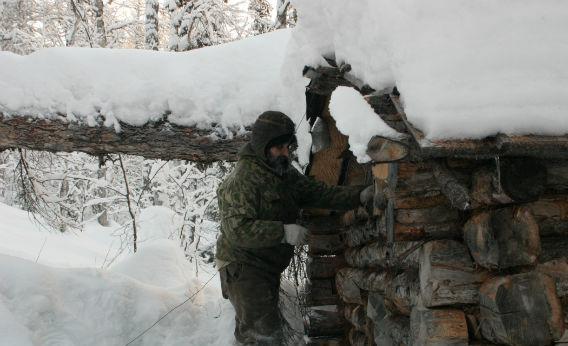Happy People: A Year in the Taiga doesn’t quite qualify as a Werner Herzog movie. Think of it more as a Herzog remix: The idiosyncratic German director culled 94 minutes of footage from a four-hour documentary the filmmaker Dmitry Vasyukov created for Russian television. Vasyukov had spent a year and a half living in a remote Siberian village, following the day-to-day life of its residents over the course of four seasons. After condensing and re-editing Vasyukov’s film for theatrical release (with the help of his son, Rudolph Herzog, and editor Joe Bini), Herzog added one of his characteristically meditative voice-overs, turning a straightforward anthropological documentary into a filmed essay on freedom, self-reliance, and the sheer miracle of another year survived in one of the planet’s harshest settled places.
Bakhtia is a remote settlement of about 300 people accessible only by helicopter and—during the parts of the year when the river flowing through it isn’t frozen solid—by boat. It’s nestled deep in the heart of the Taiga, an immense wooded region one and a half times as big as the continental United States. The people of Bakhtia lead an existence not too far removed from that of their Iron Age ancestors, hunting, trapping, fishing, and growing vegetables with tools they make themselves (plus some chainsaws and snowmobiles).
Gennady, the omnicompetent hunter/trapper with whom Herzog’s edit spends much of its time, demonstrates early on how to fashion a pair of skis from a freshly chopped-down tree, all the while extolling the virtues of a properly honed ax wedge. Later Gennady explains how to lay a trap for a sable using only tree branches, find and train a good hunting dog, and store precious winter supplies out of the reach of marauding bears. Here I’d be happy just to be able to open a new jar of pickles without help.
Much of Happy People takes place not in the village of Bakhtia itself but out in the lonesome wilderness of the Taiga, following Gennady on the fur-trapping route that takes him away from his family—and indeed, from all companionship except that of his hardworking hunting dog—during the snow-covered winter months (when a 33-degree-below-zero day counts as a balmy excuse to address some undone chores). The taciturn Gennady has a way of offhandedly segueing from sable-skinning tips into jaw-dropping stories of struggle and loss, including a still-painful memory of losing a beloved dog to a maddened bear. Later, after demonstrating the construction of that ingenious trap, he suddenly waxes reflective about the moral valence of his relationship to animals: “Come to think of it, we are all killers or accomplices.” But at least, Gennady concludes, unlike a farmer who raises animals only to slaughter them, the hunter’s relationship with the animal is “honest”: “Here, it’s about who outsmarts whom.”
Happy People’s images of the Taiga, while often breathtaking, come from the standard visual language of nature documentary: in between interviews with villagers, cutaways to icicles hanging from branches or dawn breaking over an expanse of snow. It’s Herzog’s inventive use of voice-over that elevates the film above an extremely well-researched episode of Nature. In some moments the voice-over takes off on solo flights that achieve the narrative compression of haiku: “Summer in its fullest display. Swallows, boats. Daylight lasts twenty hours.” Like haiku, Happy People is also finely attuned to the passage of the seasons: The film begins during the spring thaw, when preparations are already beginning to be made for the inevitable brutal onset of winter, and grows increasingly suspenseful as the seasons progress. Will the inhabitants of Bakhtia be able to get through the staggering amount of labor that lies before them—the stockpiling of supplies, the carving of dugout canoes, the readying of hunting cabins and setting of traps—before winter sets in and makes survival the only priority?
It’s Herzog who declares the stoic residents of Bakhtia “happy people”—with the exception of an indigenous Siberian who appears in a too-brief scene to lament the plague of alcoholism in his community, the subjects in this documentary spend little time holding forth on their state of personal well-being. Near the end, when Herzog, in voice-over, embarks on yet another lyrical flight celebrating the radical freedom and self-reliance of this largely pre-modern culture, it’s hard not to hear in his enthusiasm the idealizing nostalgia of a modern European observer, and to smile at his naiveté. But after watching Gennady and his fellow hunters spear fish in the dark of night using a method that’s remained unchanged for thousands of years, it’s even harder not to be inspired by the villagers’ ingenuity, resilience, and capacity to endure. In their honor, tomorrow I’m getting the top off the pickle jar all by myself.
